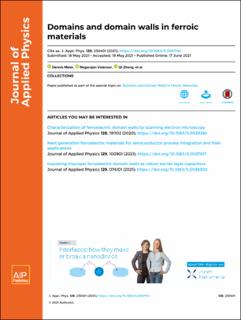| dc.description.abstract | Ferroic materials exhibit long-range order with respect to their elastic, electric, or magnetic properties, giving rise to fascinating physics and functional properties that are used in, e.g., state-of-the-art sensor technology, energy harvesting, and medical diagnosis. Despite more than 100 years of research on ferroics, this class of materials remains an exciting playground for both fundamental and applied research studies, and it is safe to predict that this trend will continue. Recent examples for the special behaviors of ferroic materials that have inspired the community are the discovery of topologically protected electric1 and magnetic2,3 skyrmions, negative capacitance,4,5 and resistive switching.6,7 Progress in the field of ferroics is propelled by the remarkable evolution that has taken place in both experimental investigations and theory, making it possible to explore the physical properties of ferroic materials with unprecedented completeness down to the length scale of individual atoms. In addition, improved synthesis methods and in situ characterization tools applied during growth allow for stabilizing novel exotic phases and artificial heterostructures to engineer ferroic properties.8,9 These capabilities have opened the door for new science and conceptually different technologies, promoting innovative fields such as low-energy spintronics10 and multi-level data storage for neuromorphic computing and next-generation nanotechnology.
Many of the current challenges, however, still fall into the basic research sector, and it is clear that we have only scratched the tip of the iceberg regarding the rich emergent nanoscale phenomena in ferroics. This is the motivation for the Special Topic on Domains and Domain Walls in Ferroic Materials. The functional response of any ferroic material inevitably relates to the formation and/or manipulation of domains and domain walls. Thus, their control via the crystallographic structure, size effects, strain, and electrostatic conditions is one of the key aspects within the field. In this Guest Editorial, we will provide a short introduction to the basic concepts and the fundamental questions that drive the modern research on ferroic domains and domain walls. In addition, a short overview of different topics covered by the articles in the Special Topic will be provided.
II. BACKGROUND | en_US |
